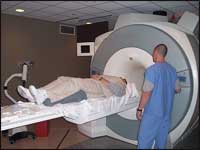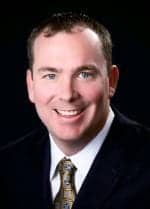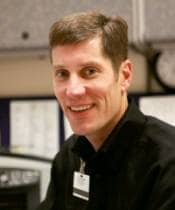
|
Governance, Mission, Growth |
CME Course: Neuroradiology and Sports Medicine
How to Attract Top-Notch Techs
The Benefits of a Paperless Practice
CME Course: Neuroradiology and Sports Medicine
Radiologists from around the country will walk past the craps tables and into the classroom when they head to Sin City in May for Stanford’s Department of Radiology’s eighth annual MR Advances in Neuroradiology and Sports Medicine Imaging. Well, at least during the day.
Under the direction of Drs Scott W. Atlas and Christopher F. Beaulieu, the 3-day continuing medical education course at Las Vegas’ Wynn Hotel will review current techniques in neuroradiology and musculoskeletal radiology. In addition to practicing radiologists, who make up a little more than 80% of the attendee pool, the event is open to orthopedic surgeons, neurosurgeons, and other medical professionals, such as nurses, radiologic technologists, physician assistants, and industry scientists.
Each year, the course draws approximately 215 to 250 attendees, the vast majority of whom hail from the United States, according to event coordinator Gaelen Lombard. It allows them to receive critical information that they could use in clinical practice—”In particular, highly specialized material on advanced bone and joint injuries both pre- and post-operatively will be covered, enabling the attendees to provide better care for referring physicians and their patients,” according to the course’s official Statement of Need.

|
Advances in MRI have grown with each new technology on the market and with each expansion of clinical applications, the statement continued. So too has the trend toward minimally invasive diagnosis and treatment of disease, which is accomplished through sophisticated imaging techniques that require a detailed knowledge of anatomy. This increasing complexity makes the course especially important for physicians who endeavor to stay current with changes in medicine.
“MR imaging now permits excellent depiction of bone and joint disorders, giving clinicians much more detailed diagnoses than in the past,” the statement concludes. “These details have helped refine practical anatomical and clinical knowledge of many of the disorders. In turn, increased clinical expectations feed back to diagnostic imaging, stimulating an appetite for more detail, more biomechanical insight, and higher expectations from the interpreting radiologist.”
Among the topics to be discussed at the event are MR imaging of the brain, spine, and sinuses; image optimization of epilepsy and stroke; the role of MR in vertebroplasty; and its function in interventional sports medicine.
Early Bird Tuition postmarked by April 1 will amount to $895 for practicing physicians; $795 for Stanford alumni, military personnel, and retired doctors; and $595 for technologists, residents, fellows, nurses, and physician assistants. Rates substantially increase if tuition is postmarked after April 1.
For more information, or to register for the course, visit radiologycme.stanford.edu/2008mradvances.
—Elaine Sanchez
How to Attract Top-Notch Techs
The American Society of Radiologic Technologists (ASRT), Albuquerque, NM, recently released its new Salary Estimator, a Web-based tool that calculates what technologists should be making based on parameters including primary discipline, facility type, title and position, credentials, and more. In the first month of its availability, the estimator was accessed by 5,820 unique visitors.
“A large proportion of the calls that the ASRT Research Department received from RTs and their managers were asking what RTs who fit a given professional profile tend to make,” explained Sal Martino, EdD, RT, vice president and chief academic officer of the ASRT Education and Research Foundation. “A salary estimator seemed an efficient way of dealing with these questions.”
According to the ASRT’s 2007 Wage and Salary Survey, around 50% of techs are happy with their salaries, while around a quarter of those surveyed said they were dissatisfied or very dissatisfied with their current wages. But the survey also indicates that for most technologists, pay is less important than such factors as “having a schedule that fits your personal needs” and “respect from physicians.”

|
Chip Hardesty, RT, MBA, executive director of Radiology Ltd, Phoenix, knows the meaning of those words well. Himself a former technologist, Hardesty has day-to-day experience in retaining talented technologists. Radiology Ltd has a staff turnover of just 3%, and members of the staff retiring or moving away account for most of that, he says.
“It’s not all about salary, but you absolutely have to be fair,” Hardesty said. “You can have the greatest working environment in the world, but the reality is that people have to pay their mortgages and take care of their children. It’s like an entry fee to be in the market. If you don’t offer fair pay and benefits, you can’t recruit the best talent.”
But after you’ve got the best talent on board, what are some strategies for creating the kind of working environment that makes techs stick around for the long haul? Hardesty confirms that a major factor is physician respect. “Our radiologists consider our technologists to be professionals,” he said. “When you’re treated like part of the team, like someone they really depend on, that comes across.”
Another way to retain talented staff is to keep the job challenging and fulfilling, says Hardesty. “The best people are smart,” he said. “They want to be challenged. Another thing that’s important is the equipment—talented people like to work in an environment where they have good equipment. And we also have a reliable support staff. When you’re an MRI tech, you want to do MRI, not paperwork. You need support staff so you can do what you love to do. That’s part of our culture, and our technologists are happy with that.”
Additionally, Radiology Ltd supports technologist education—both by “home growing” their own technologists from talented members of their support staff and by sponsoring ongoing education. “We reimburse people for the prerequisites to get into school, and once they get into the programs, we give them good scholarships,” he said. “So far, every person who’s gone through the program has been given a job when they get out. Then we get a known quantity and a quality technologist. We also spend quite a bit of money on seminars and education. If a technologist wants to go to a conference in Las Vegas, we’re very supportive.” Hardesty estimates that Radiology Ltd spends around $1,000 per tech annually for off-site training.
In the end, Hardesty says, it all comes down to the golden rule. “The most important thing for our success as a practice is how we treat each other,” he said. “All these work environment goals we’re trying to accomplish are very important to me because I was a technologist once, and there were a lot of times when I felt that my supervisors were not very fair or not very smart. People are looking for fair and professional supervisors. If you think about the best job you ever had and the worst job you ever had, it’s almost always about the people you worked with and the supervisor you answered to.”
—Cat Vasko
The Benefits of a Paperless Practice
Alvaro Garcia, MD, who runs his own family medicine practice in Houston, used plain, old-fashioned handwritten charts for the 80 patients his team of three saw each day. Often he stayed up to 2 hours after business hours closed, in order to keep up with the overwhelming load of paperwork.
“At the end of the day, I was just exhausted,” Garcia said. “My hand just ached from all the writing.”
For the sake of saving his hand, and increasing productivity, Garcia began his search for an electronic health record provider in 2004. He browsed online and looked through trade journals, and after 7 months, he came across SpringCharts, a solution from Spring Medical Systems, also based in Houston. Through an online demo, Garcia was introduced to a system he found to be “extremely user friendly” and “easy to navigate,” with pleasing graphics.
“It just hit me like a ton of bricks,” Garcia said. “I love the way this system works. I liked it so much that I asked if there was an investment opportunity.”

|
SpringCharts aims to streamline workflow by dramatically improving patient charting. With a click of his portable tablet PC, Garcia explains, he is able to view a patient’s entire health record, including family history, previous checkups, prescribed medications, and lab work results. SpringCharts prints Garcia’s prescriptions while he is meeting with a patient, he continued, saving the doctor precious minutes. Furthermore, all charts include a picture of the patient, allowing Garcia to follow a person’s progress through before-and-after pictures, see how his young patients mature into adults, and visualize who he is talking to over the phone.
“There isn’t anything SpringCharts doesn’t do that I’d need it to do,” said Garcia, whose practice has 5,500 active charts and counting. The system is also cost-effective, he continued. “It was a great system for the money,” he said.
Garcia said he believed in SpringCharts so much that he became a member of Spring Medical’s advisory committee. Since he first started using the system, he has experienced about five upgrades, resulting from customer feedback. Now he has version 9.5, containing features that allow users to access a patient’s chart without changing out of the window. Instead, everything appears on one screen. Additionally, users can sign their names directly onto the screen and store their electronic signatures.

|
| SpringCharts helps streamline workflow by dramatically improving patient charting. |
The latest enhancement also comes with all the previous applications, such as SpringCharts OffSite Remote Access, Spring Labs, a File Cabinet Document Center, and a Productivity Center that enables users to write letters, send messages, track staff office hours, process results, and retrieve documents. Garcia said he finds one chart evaluation feature particularly helpful; it lets him search for patients in need of specific exams and make the necessary appointments.
These days, Garcia is working all by himself, with his two physician assistants moving on to other things. However, he is able to see 50 patients a day, compared to the national average of 26. His office is now entirely paperless, though he still keeps the old paper records in files—reminders of the thousands of dollars he once paid monthly for chart material. Best of all, now he leaves the office right on time.
—E. Sanchez






